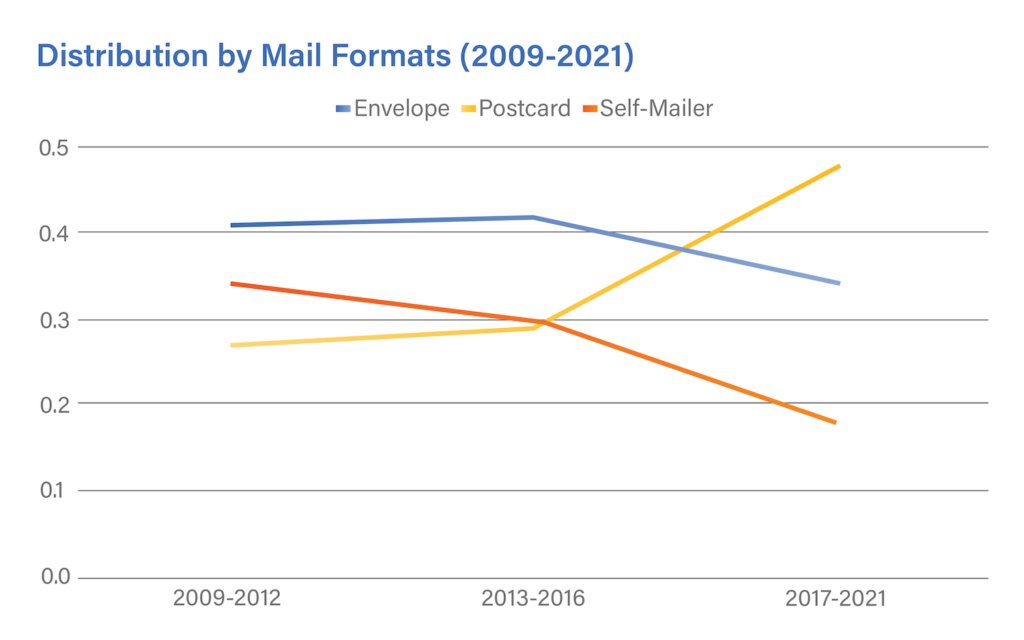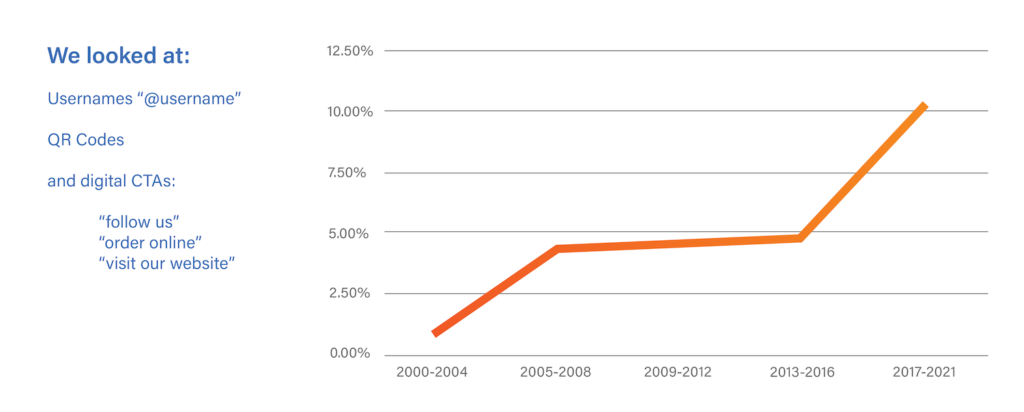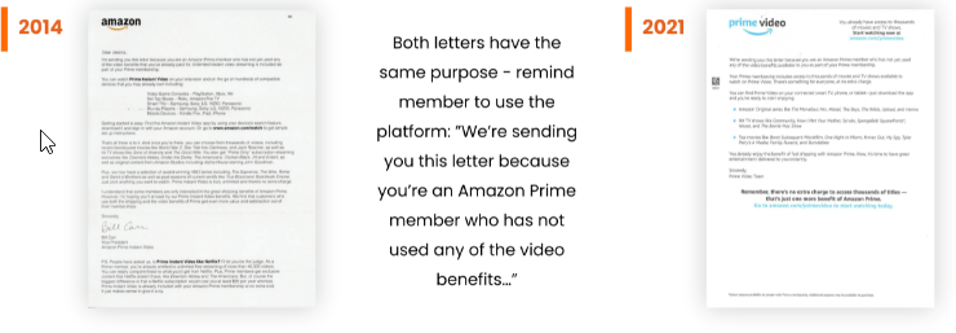What You Need to Know
In today’s world of marketing, we’re constantly surrounded by buzzwords – both old and new. As we evolve and keep up with the newest technology and trends, these buzzwords evolve as well. Yet, some buzzwords – like “Every Door Direct Mail”, otherwise known as EDDM, have stood the test of time for quite a while. In this blog, we’re breaking down this buzzword, walking you through its positives and negatives, and explaining when your company should or shouldn’t use it.
What is EDDM?
Every Door Direct Mail (better known as EDDM) from USPS is a blanketed mailing approach sent to potential customers near your business. USPS utilizes a mapping tool that holds demographic data based on census reports, such as age-range, household size, and income. Factors like these can help your company choose the routes you’d like to deliver your mail piece(s) to. Additionally, you can schedule that delivery for any time mail gets delivered.
You may create the mailer yourself, but it’s recommended you work with a company (like Strata) to help you design both professionally and effectively. The USPS website states, “Based on your unique business needs, either create an EDDM mailing yourself or get help with any part of the mail design, printing, preparation, and drop-off process using USPS affiliate vendors or find a local printer in the USPS Printer Directory.”
What Does it Cost?
The cost of EDDM varies, but it’s usually a lower cost option for marketing mail (which we’ll go over later on in this blog). You first have to choose between two options, EDDM Retail and EDDM BMEU, which you can read more in-depth about, here. The costs associated with these options are as follows:
- EDDM Retail® USPS Marketing Flats – $0.20 per piece
- EDDM BMEU USPS Marketing Mail Flats – as low as $0.168 per piece
What’s Good About EDDM?
EDDM is a good option to have if your marketing budget is low. It’s also possible to use it as a marketing test-run to see what audience members are most likely to respond to your communication (especially if you don’t have the budget for reporting).
It’s most often used for generalized, non-specific marketing awareness or brand campaigns. If you simply want to get the word out there – to anyone and everyone about your business, EDDM is an option to consider. Using EDDM can help you to avoid high postage rates, as long as you have a smaller print job in one geographic area.
Why Should I Consider Not Using EDDM?
EDDM definitely comes with its trade-offs. With it, you’ll lose the ability to target individuals based on very specified credentials, and won’t have as much leeway when it comes to time-to-market. Additionally, if your EDDM campaign is too large the cost savings you’d get with postage would be practically meaningless due to the increase in production processing. Lastly, EDDM doesn’t give you any options in terms of personalization – which, if you’ve read some of our blogs, you know is important in direct mail campaign effectiveness and ROI.
What are the Alternatives?
Before using EDDM, think through other ways you can get your message across, and who you’re trying to get that message to. Instead of using a blanketed geographic approach, you may want to try a more specified campaign like our SmartMove services (personalized, multi-touch mail that’s sent specifically to new movers). This way, you can better pin-point your audience, and provide a better experience to those who receive your mail.
Or, maybe the best marketing strategy for your company isn’t even mail at all, or is mail that includes a digital touchpoint. A more multichannel campaign could be your answer.
EDDM isn’t for every company and its marketing strategy – but as experts in the industry, we can say that it works for some companies. Yet, there are many times a more targeted strategy, like our new mover marketing options, will work better. Wondering how you can get started on your next direct mail or multichannel campaign? We’re here to help. Simply contact us whenever you’re ready.
From QR Codes to Concise Copy
Direct mail trends can be difficult to forecast, and even harder to use correctly and efficiently. However, you’re in luck, because as direct mail experts, we’re providing you with the top 10 direct mail trends – from QR Codes to concise copy – that have and continue to dominate 2021.
1. QR Codes
In the last few years, QR codes have really built a name for themselves. Not only because of their quick, digital nature, and the 2% postage cost break that comes with them, but because of their data-backed effectiveness. When a QR code is included in a way that makes sense- it provides a time-saving benefit to the customer while letting the company lead their customer exactly where they’d like them to go.
Although the year 2020 was detrimental for most industries and marketing tools, the QR code flourished. During a time where we didn’t want to physically touch anything, QR codes made up for physical marketing pieces like menus, signage, print ads, and flyers, leading customers from physical to digital – and quickly. The more QRs were seen, the more used to them we became (similar to our newfound familiarity with masks and hand sanitizer). And they’re still going strong in 2021.
Like we said, QRs lead customers to wherever a company would like them to go. They can provide helpful information, send the customer to a website, or even lead them to purchase.
2. Postcards on the Rise
Envelopes – they’re great and all, but let’s be honest, they add a few seconds (at least) to the time it takes to open (and read) direct mail. These days, it’s often better to send a postcard due to its more creative, eye-catching nature and faster access to information. Making it easier to read your call-to-action can often make customers more likely to respond to an offer or even visit a website or landing page for more information. Plus, they’re lower in cost – which means a better chance of higher ROI for your campaigns. As you can see below, postcards pushed past self-mailers and envelopes this year by quite a bit.
3. B2B Dimensional Mailers
These fun, three-dimensional, interactive mailers are the perfect way to stand out and cut through the clutter of everyday mail. “On the B2B side, dimensional mail is working well; because we all receive so many packages today, prospects want to open it and see what’s inside,” says Grant Johnson, Owner and CEO of Responsory. Although more costly and demanding in terms of postal handling, dimensional mail has the best B2B response rate at 8.51%. Check out our blog on the best secrets to a successful dimensional mailer campaign to get started on your own.
4. Better Segmentation with Data
“Accessing 1st and 3rd party data to further segment an audience will continue to play a huge role in a DM campaign’s success. If you’re able to align targeted messaging and great creative with those different segments, then that’s a recipe for increased response rates. Furthermore, surrounding that DM send with a similar message/offer through various digital channels will only add to that campaign’s success. Being able to hone in on delivery dates and putting an emphasis on speed to market are big contributors to making a direct mail/digital integration program thrive.”
– Mike Efstathios, Business Development at ICS Corporation
Data, data, data. It’s all everyone can talk about these days – and for good reason. Enriching your data qualifies your audience, and in turn, increases your ROI. And, if your marketing strategy is multi- or omnichannel, the customer experience becomes even more successful. While better segmenting your data may cause your audience to shrink, it will definitely cause your engagement to grow. Like we always say – it’s better to target the right people than all the people.
5. Increased Personalization
88% of marketers recently reported seeing better campaign metrics after using personalization in their advertising. More than ever before, the need for marketers to make human connections is extremely relevant, and some may even say necessary. The majority of our population feels they’ve lost personal connections and relationships due to the pandemic. Because of this, 2020-2021 has been the time to make up for lost connections by personalizing materials to bond with your audience and make them feel seen, heard, and human. Check out our blog on the best ways to get personal, here.
6. Higher Response Rates
Since the beginning of 2021, we’ve seen a rise in direct mail response rates. Why? More time at home means more time to go through – and even pay attention to, mail. And as the trend of working from home and staying at home has continued and even increased, response rates don’t seem to be dwindling anytime soon.
However, high response rates don’t just come from people staying put. They come from quality tracking, targeting, design, and audience awareness. For more tactics to increase response rates, visit this blog.
7. Interactive Direct Mail
In today’s world, we’re surrounded by technology. And with all of this technology, there’s no reason we shouldn’t be incorporating it into our direct mail efforts. 2021 brought new technology and an abundance of data that empowers companies when targeting audiences and crafting content. Next time you’re sending direct mail – think about how far you can go with it. Can it include a scratch-off? A game? A free kit or item? A contest? It’s pretty limitless.
8. Digital Prompts
Direct mail isn’t only a way to reach customers, but an excellent way to reinforce online efforts. Simply use social icons, QR codes, or other prompts to send customers to social platforms, websites, menus, forms, landing pages – you name it! Marketers are definitely catching on to this direct mail tactic, as usage of digital prompts has doubled in the last four years. Take a look at the chart below to see how the use of digital interactions has increased.
9. Concise Copy
It’s one thing to know what you want to say, but knowing how to say it is the real key to direct mail effectiveness. Throughout 2021, we’re seeing shorter sentences, smaller paragraphs, fewer bullet points, and obvious CTAs. Your audience’s attention span is only so long, so catching the ears and eyes right away is crucial.
Below is a great example of how Amazon has practiced this and changed their copy to be more concise and clearer. Even at just a quick glance, the message is less overwhelming and more approachable.
Need some help with your direct mail copy? We’ve got a blog for you on ways to write action-inspiring content.
10. Investing in Direct Mail Tools
Although it’s not always top of mind, the right tools are one of the most important components of great direct mail. If you haven’t looked into or invested in marketing and data tools, you should be, because they can take your direct mail from general and stale to effective and exciting, and in turn, save you time and money. Instead of targeting the wrong contacts or using the wrong design elements, the right tools will ensure your mailer looks great and is sent to people who will actually open and engage with it.
Consider changing your format, ink, paper, or finish. Update your branding, content, or calls to action. Or, try technology like USPS Informed Delivery to reach consumers in a modern way.
So, there you have it! 10 effective direct mail trends that took off this year. If you’re interested in learning more about enhancing your direct mail, feel free to contact the experts at Strata. We’re happy to get you started with some great direct marketing materials.
The 9 Most Unique Ways to Use Print in Your Marketing
Over the past two weeks, if you’ve been keeping up with our blog, you’ve gotten the chance to hear about the true power print holds. We’ve shared why print is still so powerful in today’s marketing world, as well as tips and tricks on how to improve your current print marketing practices. Print is trustworthy, cost-effective, results-driven, and sticks with customers, and we’re here to show just that. For our final blog of The Power of Print series, we’re taking you through the 9 most unique (and powerful) ways your company can use print marketing.
1. Letters & Postcards
“Letters and postcards” can really mean a variety of things. From packages to flyers – to dimensional mailers, sending these to customers and prospects gives you a chance to include personalized messages, catered services, tailored specials and more to gain their brand loyalty and trust while breaking through the digital noise. They won’t go to waste, as 44% of customers visit a brand’s website after receiving direct mail marketing.
2. Newsletters & Updates
You may already be sending out an e-newsletter or monthly updates to your customers to keep them in the know, advertise new products and services, and send upcoming company and event information. Why not switch it up and give them a surprise with a printed version every so often? For printed newsletters or update materials, you can choose from a wide range of materials, layouts, shapes, and sizes to share your company’s news in a fun, eye-catching, and creative way.
3. Business Cards
Business cards have been around for years, and there’s a reason they’re still used currently, despite all of the digital options available. Not only do business cards share your contact information quickly and effectively with others, but with all of the print options of today, they give you a chance to further show your brand’s quality and creativity. Unique and eye-catching business cards will always be great tools at networking events and social gatherings, and are a great way to stay on the minds of potential customers.
4. Loyalty Cards
This simple yet powerful tool will keep your customers coming back and get them excited to do so. Using loyalty program pieces or punch cards with your logo and brand is a great way to advertise and market your business, its products, and its services. Even better – make these cards super quick and easy to use by including a QR code that tracks customer purchases. Studies have shown that up to 64% of small businesses that have implemented a customer loyalty program have found that the program earns the business more money than it took to create – so get the most bang for your buck with this simple and effective print marketing piece.
5. Posters, Flags, & Banners
Posters, flags, and banners are physical marketing pieces that are so large that you can’t really ignore them. These are great advertising options because of their scale, cost effectiveness, and longevity. Use them in store, hang them in your windows, post them around town, hang them up at a tradeshow – over and over again. Spend a bit more on print quality, and you can use them for years to come.
6. Promotional Products
These non-paper items are a great print option that not everyone always thinks about. Almost every household in America has at least one magnet on their refrigerator – so, let’s make sure that one magnet promotes YOUR business. Or, place your logo and a unique design on a sticker to go on a laptop, water bottle, or phone case. Whatever makes the most sense for your audience, print it. If they like it enough and use it, you’ll get some free marketing promotion as they sport your company t-shirt, use your branded water bottle, or share your logoed hand sanitizer. Hand out these promotional items at trade shows and events, send them in the mail, or give them out as a parting gift after face-to-face meetings.
7. Calendars
Printed, branded calendars are a great opportunity to showcase your brand or products – for 365 days of the year. Offering these to clients and potential customers is a great relationship starter, and since calendars are usually front and center on desks and office walls, your company’s name has a higher chance of being remembered.
8. Brochures
Probably one of the most well-known ways to share company information, a brochure is a quick and traditional piece to remind customers of what you represent and what you have to offer. 48% of people retain direct mail for future reference – so sending them a brochure ensures that they can go back to your company information any time they’d like. Furthermore, brochures are versatile. They can be sent out, placed in establishments, or handed out at events. There are endless places and ways to get brochures circulating to share your brand and offerings.
9. Catalogs
The catalog has come a long way, and in today’s digital world, it’s much easier to design and print. The catalog is an extremely budget friendly way to share your products, and, like other print materials, it’s a great way to show your company’s quality and care by using thoughtful paper, color, and texture choices. It’s also a unique way to stand out among your competitors, and again, break through the digital noise of today.
Looking for ways to incorporate the power of unique print into your next marketing campaign? At Strata, we’re print experts (it’s in our DNA) and we’re ready to help! Contact us today to start brainstorming your next eye-catching print project.




